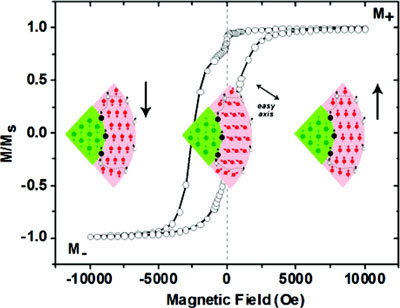| Feb 15, 2011 |
Complexity in core-shell nanomagnets
|
|
(Nanowerk News) The magnetic exchange bias coupling between core and shell depends critically on the "frozen spins" that reside at the interface between the two different magnetic nanomaterials, according to users from Purdue University working with the Electronic & Magnetic Materials & Devices Group ("Role of Frozen Spins in the Exchange Anisotropy of Core-Shell Fe@Fe3O4 Nanoparticles").
|
|
The relative population of such frozen spins can be modulated by external physical parameters, such as the strength of the applied cooling field and the cycling history of magnetic field sweeps (training effect). A more complex change occurs when core-shell nanoparticles are aged under ambient conditions. Along with structural evolution from well-defined core-shell nanostructures to nanoparticles containing multiple voids at the interface, there is a significant increase in the population of frozen spins, both of which affect the magnetic properties.
|
 |
| (curves) Magnetic hysteresis of core-shell Fe@Fe3O4 nanoparticles at 5 K under field cooling (+10 kOe). (color images) Cutaway (micromagnetic) view of spin configurations in a core-shell nanoparticle during a field sweep under field cooling conditions. Filled circles (green, red, and black) represent magnetic moments in the ferromagnetic core, ferrimagnetic shell, and core-shell interface, respectively. For simplicity, each ferrimagnetic domain in the shell layer is represented as a spin lattice with a net moment. Dashed lines demarcate the boundaries of crystalline domains within the shell layer, and open circles indicate residual (uncompensated) spins at the surface or domain boundaries. \
|
|
Core-shell Fe@Fe3O4 nanoparticles exhibit substantial exchange bias at low temperatures, mediated by unidirectionally aligned moments at the core-shell interface. These spins are frozen into magnetic alignment with field cooling and are depinned in a temperature-dependent manner. The population of such frozen spins has a direct impact on both coercivity (HC) and the exchange-bias field (HE), which are modulated by external physical parameters, such as the strength of the applied cooling field and the cycling history of magnetic field sweeps (training effect).
|
|
Aging of the core-shell nanoparticles under ambient conditions results in a gradual decrease in magnetization but overall retention of HC and HE, as well as a large increase in the population of frozen spins. These changes are accompanied by a structural evolution from well-defined core-shell structures to particles containing multiple voids, attributable to the Kirkendall effect. Energy-filtered and high-resolution transmission electron microscopy both indicate further oxidation of the shell layer, but the iron core is remarkably well preserved.
|
|
The increase in frozen spin population with age is responsible for the overall retention of exchange bias, despite void formation and other oxidation-dependent changes. The exchange-bias field becomes negligible upon deliberate oxidation of Fe@Fe3O4 nanoparticles into yolk-shell particles, with a nearly complete physical separation of core and shell.
|

